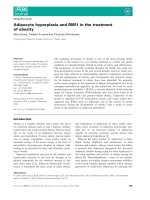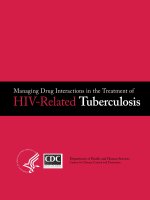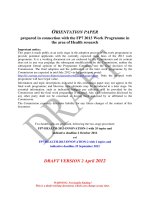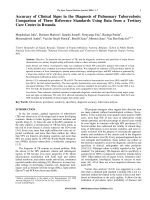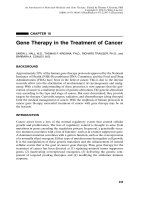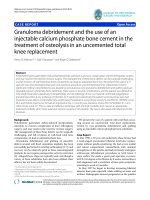Managing Drug Interactions in the Treatment of HIV-Related Tuberculosis docx
Bạn đang xem bản rút gọn của tài liệu. Xem và tải ngay bản đầy đủ của tài liệu tại đây (229.21 KB, 20 trang )
Managing Drug Interactions in the Treatment of
HIV-Related Tuberculosis
Department of Health and Human Services
Centers for Disease Control and Prevention
Centers for Disease Control and Prevention
Coordinating Center for Infectious Diseases
National Center for HIV/AIDS, Viral Hepatitis, STD, and TB Prevention
Division of Tuberculosis Elimination
December 2007
is document is accessible online at
Suggested citation
: CDC. Managing Drug Interactions in the Treatment of HIV-Related Tuberculosis
[online]. 2007. Available from URL:
Managing Drug Interactions in the Treatment of
HIV-Related Tuberculosis
Introduction
0
5
e Role of Rifamycins in Tuberculosis Treatment
0
5
Predicting Drug Interactions Involving Rifamycins
0
6
Rifampin and Antiretroviral erapy
0
6
Rifabutin and Antiretroviral erapy
0
8
Special Populations
0
9
Limitations of these Guidelines 11
References 12
Table 1. Recommendations for regimens for the concomitant
treatment of tuberculosis and HIV infection 15
Table 2. Recommendations for coadministering antiretroviral
drugs with RIFAMPIN 16
Table 3. Recommendations for coadministering antiretroviral
drugs with RIFABUTIN 18
Table of Contents
5
Introduction
Worldwide, tuberculosis is the most common opportunistic infection among people with HIV infection. In
addition to its frequency, tuberculosis is also associated with substantial morbidity and mortality. Despite the
complexities of treating two infections requiring multidrug therapy at the same time, antiretroviral therapy
can be life-saving among patients with tuberculosis and advanced HIV disease. Observational studies in
a variety of settings have shown that use of antiretroviral therapy during tuberculosis treatment results in
marked decreases in the risk of death or other opportunistic infections among persons with tuberculosis and
advanced HIV disease
1, 2
.
Concomitant use of treatment for tuberculosis and antiretroviral therapy is complicated by the adherence
challenge of polypharmacy, overlapping side eff ect profi les of antituberculosis drugs and antiretroviral drugs,
immune reconstitution infl ammatory syndrome, and drug-drug interactions
3
. e key interactions, and the
focus of this document, are those between the rifamycin antibiotics and four classes of antiretroviral drugs:
protease inhibitors, non-nucleoside reverse-transcriptase inhibitors [NNRTI], CCR5-receptor antagonists,
and integrase inhibitors
3
. Only two of the currently available antiretroviral drug classes, the nucleoside
analogues (other than zidovudine
4
) and enfuvirtide (a parenteral entry inhibitor) do not have signifi cant
interactions with the rifamycins.
e purpose of this summary is to provide the clinician with updated recommendations for managing the
drug-drug interactions that occur when using antiretroviral therapy during tuberculosis treatment. Changes
from previous versions of these guidelines include: an eff ort to obtain and summarize the clinical experience
of using specifi c antiretroviral regimens during tuberculosis treatment (not just pharmacokinetic data), a
table summarizing the clinical experience with key antiretroviral regimens and providing recommended
regimens (Table 1), and sections on treatment for special populations (young children, pregnant women,
patients with drug-resistant tuberculosis). We include drug-drug interaction data for antiretroviral drugs that
have been approved or are currently available through expanded access programs in the United States; these
recommendations will be updated as additional antiretroviral drugs progress become available.
The Role of Rifamycins in Tuberculosis Treatment
Despite the complexity of these drug interactions, the key role of the rifamycins in the success of
tuberculosis treatment mandates that the drug-drug interactions between the rifamycins and antiretroviral
drugs be managed, not avoided by using tuberculosis treatment regimens that do not include a rifamycin
or by withholding antiretroviral therapy until completion of anti-tuberculosis therapy among patients with
advanced immunodefi ciency. In randomized trials, regimens without rifampin or in which rifampin
was only used for the fi rst two months of therapy resulted in higher rates of tuberculosis treatment failure
and relapse
5, 6
. e sub-optimal performance of the regimen of two months of rifampin (with isoniazid,
pyrazinamide, and ethambutol) followed by 6 months of isoniazid + ethambutol was particularly notable
among participants with HIV co-infection
5
. erefore, patients with HIV-related tuberculosis should be
treated with a regimen including a rifamycin for the full course of tuberculosis treatment, unless the isolate is
resistant to the rifamycins or the patient has a severe side eff ect that is clearly due to the rifamycins.
Furthermore, patients with advanced HIV disease (CD4 cell count < 100 cells/mm
3
) have an increased risk
of acquired rifamycin resistance if treated with a rifamycin-containing regimen administered once or twice-
weekly
1, 7
. e rifamycin-based regimen should be administered daily (5-7 days per week) for at least the fi rst
2 months of treatment among patients with advanced HIV disease
8, 9
.
6
Predicting Drug Interactions Involving Rifamycins
Knowledge of the mechanisms of drug interactions can help predict the likelihood of an interaction, if that
specifi c combination of drugs has not been formally evaluated. e rifamycin class upregulate (induce) the
synthesis of several classes of drug transporting and drug metabolizing enzymes. With increased synthesis,
there is increased total activity of the enzyme (or enzyme system), thereby decreasing the serum half-life and
serum concentrations of drugs that are metabolized by that system. e most common locus of rifamycin
interactions is the cytochrome P450 enzyme system, particularly the CYP3A4 and CYP2C8/9 isozymes.
To a lesser extent, rifampin induces the activity of the CYP2C19 and CYPD6 isozymes. e rifamycins
vary in their potential as CYP450 inducers, with rifampin being most potent, rifapentine intermediate, and
rifabutin being much less active. Rifampin also upregulates the synthesis of cytosolic drug-metabolizing
enzymes, including glucuronosyl transferase, an enzyme involved in the metabolism of zidovudine
10
and raltegravir.
Rifampin and Antiretroviral Therapy
e most important drug-drug interactions in the treatment of HIV-related tuberculosis are those between
rifampin and the NNRTIs, efavirenz and nevirapine. Rifampin is the only rifamycin available in most of
the world, and initial antiretroviral regimens in areas with high rates of tuberculosis consist of efavirenz or
nevirapine (in combination with nucleoside analogues). Furthermore, because of its potency and durability
in randomized clinical trials, efavirenz-based therapy is a preferred option for initial antiretroviral therapy in
developed countries.
Rifampin and Efavirenz
Rifampin causes a measurable, though modest, decrease in efavirenz concentrations
11, 12
(Table 2). Increasing
the dose of efavirenz from 600 mg daily to 800 mg daily compensates for the eff ect of rifampin
11, 12
, but it
does not appear that this dose increase is necessary to achieve excellent virological outcomes of
therapy
12
. Trough concentrations of efavirenz, the best predictor of its virological activity, remain well above
the concentration necessary to suppress HIV in vitro among patients on concomitant rifampin
13
.
A testament to the potency of efavirenz against HIV is that the standard dose of efavirenz results in very high
rates of complete viral suppression despite 10-fold interpatient diff erences in trough concentrations. erefore,
it is unlikely that the 20% decrease in serum concentrations resulting from rifampin will have a clinically-
signifi cant eff ect on antiretroviral activity. In several cohort studies, antiretroviral therapy of standard-dose
efavirenz + 2 nucleosides was well-tolerated and highly effi cacious in achieving complete viral suppression
among patients receiving concomitant rifampin-based tuberculosis treatment
14, 15
. Furthermore, there was
no apparent benefi t from a higher dose of efavirenz (800 mg daily) in one randomized trial
12
, and a small
observational study documented high serum concentrations and neurotoxicity among 7 of 9 patients receiving
the 800 mg dose with rifampin
16
. erefore, this combination – efavirenz-based antiretroviral therapy and
rifampin-based tuberculosis treatment, at their standard doses – is the preferred treatment for HIV-related
tuberculosis (Table 1). Some experts recommend the 800 mg dose of efavirenz for patients weighing > 60 kg.
Alternatives to Efavirenz-Based Antiretroviral Therapy
Alternatives to efavirenz-based antiretroviral therapy are needed for patients with HIV-related tuberculosis:
efavirenz cannot be used during pregnancy (at least during the fi rst trimester), some patients are intolerant to
efavirenz, and some are infected with NNRTI-resistant strains of HIV.
7
Rifampin and Nevirapine
Rifampin decreases serum concentrations of nevirapine by 20-55%
17, 18
(Table 1). e common toxicities
of nevirapine – skin rash and hepatitis – overlap common toxicities of some fi rst-line antituberculosis drugs.
Furthermore, nevirapine-based regimens are not recommended for patients with higher CD4 cell counts
(> 350 cells/mm
3
for men, > 250 cells/mm
3
for women) because of increased risk of severe hypersensitivity
reactions. erefore, there are concerns about the effi cacy and safety of using nevirapine-based antiretroviral
therapy during rifampin-based tuberculosis treatment. At present, there have been no studies comparing
efavirenz vs. nevirapine-based antiretroviral therapy among patients being treated for tuberculosis. Trough
serum concentrations of nevirapine among patients on concomitant rifampin often exceed the concentration
necessary to suppress HIV in vitro
17, 19
. Several cohort studies have shown high rates of viral suppression
among patients receiving nevirapine-based antiretroviral therapy
17, 20
. e risk of hepatitis among such
patients was also comparable to patients receiving fi rst-line tuberculosis treatment without antiretroviral
therapy
20
. Despite the interaction with rifampin, nevirapine-based antiretroviral therapy appears to be
reasonably eff ective and well-tolerated among patients being treated for tuberculosis.
ese studies are neither adequately powered nor reported in suffi cient detail to fully answer the concerns
about the effi cacy and safety of nevirapine-based antiretroviral therapy during tuberculosis treatment.
However, the collected experience is suffi cient to make nevirapine an alternative for patients unable to take
efavirenz and who do not have access to rifabutin. Some investigators have suggested using an increased
dose of nevirapine among patients on rifampin
18
. However, a recent randomized trial comparing standard
dose nevirapine (200 mg twice-daily) to a higher dose (300 mg twice daily) among patients on rifampin
demonstrated an increased risk of nevirapine hypersensitivity among patients randomized to the higher dose
of nevirapine
21
. erefore, the standard dose of nevirapine should be used among patients on rifampin (200
mg daily for 2 weeks, followed by 200 mg twice-daily).
Other Antiretroviral Regimens for use with Rifampin
For patients who are infected with NNRTI-resistant HIV, neither efavirenz nor nevirapine will be eff ective.
Unfortunately, there is little clinical experience with alternatives to NNRTI-based therapy among patients
being treated with rifampin. Standard doses of protease inhibitors cannot be given with rifampin (Table 1);
the > 90% decreases in trough concentrations of the protease inhibitors would surely make them
ineff ective
22-24
. Most protease inhibitors are given with low-dose ritonavir (100-200 mg per dose of the
other protease inhibitor). However, low-dose ritonavir does not overcome the eff ects of rifampin; serum
concentrations of indinavir, lopinavir, and atazanavir were decreased by > 90% when given with the standard
ritonavir boosting dose (100 mg) in the presence of rifampin
23-25
, and a once-daily regimen of ritonavir-
boosted saquinavir (saquinavir 1600 mg + ritonavir 200 mg) resulted in inadequate concentrations of
saquinavir
26, 27
. erefore, standard protease inhibitor regimens, whether boosted or not, cannot
be given with rifampin.
e dramatic eff ects of rifampin on serum concentrations of other protease-inhibitors can be overcome with
high-doses of ritonavir (400 mg twice-daily, “super-boosted protease inhibitors”) or by doubling the dose of
the co-formulated form of lopinavir/ritonavir
23
. However, high rates of hepatoxicity occurred among healthy
volunteers treated with rifampin and ritonavir-boosted saquinavir (saquinavir 1000 mg + ritonavir 100 mg
twice-daily
28
) and those treated with rifampin and lopinavir/ritonavir (either as lopinavir 400 mg + 400 mg
ritonavir twice-daily or as lopinavir 800 mg + ritonavir 200 mg twice-daily)
23, 29
.
Whether patients with HIV-related tuberculosis will have the same high rates of hepatotoxicity when treated
with super-boosted protease inhibitors or double-dose lopinavir/ritonavir has not been adequately studied.
Among patients receiving rifampin-based tuberculosis treatment, the combination of ritonavir-boosted
saquinavir (400 mg of each, twice daily) was not well-tolerated
30
. e initial positive experience with super-
8
boosted lopinavir among young children (see below) suggests that these regimens may be tolerable and
eff ective among at least some patients with HIV-related tuberculosis. However, these regimens should only
be used with close clinical and laboratory monitoring for possible hepatoxicity, when there is a pressing need
to start antiretroviral therapy.
Regimens composed entirely of nucleoside analogues are less active than combinations of two classes of
antiretroviral drugs (e.g., NNRTI + nucleosides)
31
. A regimen of zidovudine, lamivudine, and the nucleotide
agent, tenofovir, has been reported to be active among patients on rifampin-based tuberculosis
treatment
32
. However, this regimen has not been compared to standard initial antiretroviral therapy
(e.g., efavirenz + 2 nucleosides). Finally, a quadruple regimen of zidovudine, lamivudine, abacavir, and
tenofovir has been reported to be as active as an efavirenz-based regimen in an initial small trial
33
. While
these regimens of nucleosides and nucleotides cannot be recommended as preferred therapy among patients
receiving rifampin, their lack of predicted clinically-signifi cant interactions with rifampin make them an
acceptable alternative, for patients unable to take NNRTIs or those with NNRTI-resistant HIV
32, 34
.
Rifampin has substantial interactions with the recently-approved CCR5-receptor antagonist, maraviroc
35
.
An increased dose of maraviroc has been recommended to allow concomitant use of rifampin and
maraviroc, but there is no reported clinical experience with this combination. Rifampin decreases the
trough concentrations of raltegravir, the recently-approved integrase inhibitor, by ~ 60%
36
. Because the
antiviral activity of raltegravir 200 mg twice daily was very similar to the activity of the licensed dose (400
mg twice-daily), the current recommendation is to use the standard dose of raltegravir in a patient receiving
concomitant rifampin. However, this combination should be used with caution – there is very little clinical
experience with using concomitant raltegravir and rifampin. Finally, rifampin is predicted to substantially
decrease the concentrations of etravirine (a second-generation NNRTI
37
currently available through an
expanded access program). Additional drug-interaction studies will be needed to further evaluate whether
these new agents can be used among patients receiving rifampin-based tuberculosis treatment.
Rifabutin and Antiretroviral Drugs
Rifabutin is as eff ective for tuberculosis treatment as rifampin
38, 39
, but has much less eff ect on drugs
metabolized through the CYP3A system
40
(Table 3). However, rifabutin is either not available or is very
expensive in countries with high rates of HIV-related tuberculosis. Furthermore, some antiretroviral drugs
have a substantial eff ect on rifabutin concentrations, necessitating somewhat complex dosing guidelines
for rifabutin in the setting of antiretroviral therapy (see Table 3). In addition to their complexity, there is
another potential problem of using rifabutin for tuberculosis treatment. If a patient whose rifabutin dose was
decreased in response to antiretroviral therapy then stops taking the interacting drug (e.g., ritonavir), the
resulting rifabutin concentrations are likely to be sub-therapeutic. ese factors, in addition to the limited
availability of the drug, limit the use of rifabutin in the treatment of HIV-related tuberculosis.
Rifabutin and Protease Inhibitors
Rifabutin has little, if any eff ect on the serum concentrations of protease-inhibitors (other than unboosted
saquinavir)
22
. Cohort studies have shown favorable virological and immunological outcomes of protease-
inhibitor-based antiretroviral therapy in the setting of rifabutin-based tuberculosis treatment
1, 41
. ough no
comparative studies have been done, the combination of rifabutin (if available) with protease-inhibitor based
antiretroviral therapy is the preferred form of therapy for patients unable to take NNRTI-based antiretroviral
therapy (Table 1). As above, there are concerns about the safety of super-boosted protease-inhibitors and the
effi cacy of nucleoside-only regimens in the setting of rifampin-based tuberculosis treatment.
e protease-inhibitors, particularly if pharmacologically boosted with ritonavir, markedly increase serum
concentrations and toxicity of rifabutin
42
. erefore, the dose of rifabutin should be decreased when used
with protease-inhibitors (Table 3). As above, the decreased dose of rifabutin would be sub-therapeutic if
9
the patient stopped taking the protease-inhibitor without adjusting the rifabutin dose. erefore, adherence
to the protease-inhibitor should be assessed with each dose of directly observed tuberculosis treatment; one
convenient way to do so is to give a supervised dose of protease-inhibitor at the same time as the directly
observed dose of tuberculosis treatment.
Special Populations
Pregnant women
A number of issues complicate the treatment of the HIV-infected woman who is pregnant and has active
tuberculosis. Efavirenz is contraindicated during at least the fi rst 1-2 trimesters. Furthermore, pregnant
women have an increased risk of severe toxicity from didanosine and stavudine
43
, and women with CD4
cell counts > 250 cells/mm
3
have an increased risk of nevirapine-related hepatitis
44
. erefore, the choice of
antiretroviral agents is limited among pregnant women.
Pregnancy alters the distribution and metabolism of a number of drugs, including antiretroviral drugs
45
(there is very little information on whether the metabolism of anti-tuberculosis drugs is altered during
pregnancy). Notably, the serum concentrations of protease-inhibitors are decreased during the latter stages
of pregnancy
46, 47
. ere are no published data on drug-drug interactions between anti-tuberculosis and
antiretroviral drugs among pregnant women. However, it is likely that the eff ects of rifampin on protease
inhibitors are exacerbated during pregnancy.
In the absence of pharmacokinetic data and published clinical experience it is diffi cult to formulate guidelines
for the management of drug-drug interactions during the treatment of HIV-related tuberculosis among
pregnant women. Nevirapine-based therapy could be used among women on rifampin-based tuberculosis
treatment, with the caveat that there be a good monitoring system for symptoms and laboratory tests
for hepatotoxicity. Efavirenz-based therapy may be an option during the later stages of pregnancy. e
quadruple nucleoside/nucleotide regimen (zidovudine, lamivudine, abacavir, and tenofovir) is an alternative,
though additional experience is required, particularly during pregnancy. Finally, despite their sub-optimal
activity, triple nucleoside or nucleoside/nucleotide regimens are an alternative during pregnancy. Where
rifabutin is available, the preferred option is protease-inhibitor-based antiretroviral therapy.
Children
HIV-infected children in high-burden countries have very high rates of tuberculosis, often with severe, life-
threatening manifestations (e.g., disseminated disease, meningitis). Such children may also have advanced
and rapidly-progressive HIV disease, so there are pressing reasons to assure potent treatment for both
tuberculosis and AIDS. In addition to the complexities raised by the drug interactions discussed above,
children with HIV-related tuberculosis raise other challenges. ere are very limited data on the absorption,
metabolism, and elimination of anti-tuberculosis drugs among children, particularly among very young
children (< 2 years of age).
Some antiretroviral agents are not yet available in suspension formulations, and there are limited
pharmacokinetic data for all antiretroviral drugs among young children. e use of single-dose nevirapine
selects for NNRTI-resistant strains among those infants who are infected despite perinatal prophylaxis, and
such children have inferior outcomes if subsequently treated with nevirapine-based combination antiretroviral
therapy
48
. erefore, there is understandable reluctance to use NNRTI-based therapy among perinatally-
infected infants who were exposed to single-dose nevirapine. As above, the inability to use NNRTI-based
antiretroviral therapy limits options for antiretroviral therapy among children receiving rifampin-based
tuberculosis treatment.
10
ere are emerging, though unpublished, pharmacokinetic data and clinical experience with using protease-
inhibitor-based antiretroviral therapy among young children (< 5 years of age) with HIV-related tuberculosis.
Children treated with super-boosted lopinavir (ritonavir in addition to doses of co-formulated lopinavir/
ritonavir) while on rifampin-based tuberculosis treatment had serum concentrations of lopinavir comparable
to those of children treated with standard dose lopinavir/ritonavir in the absence of rifampin
49
. Furthermore,
a cohort study found similar virological and immunological outcomes of antiretroviral therapy among
children treated with super-boosted lopinavir and rifampin-based tuberculosis treatment compared with
children treated with standard dose lopinavir/ritonavir
50
. erefore, super-boosted lopinavir plus appropriate
nucleoside agents is the preferred antiretroviral regimen among children on rifampin-based tuberculosis
treatment.
e triple nucleoside regimen of zidovudine, lamivudine, and abacavir has been suggested for young children
who are taking rifampin-based tuberculosis treatment
51
. However, there is limited published clinical
experience with this regimen among young children, with or without concomitant tuberculosis. Furthermore,
young children often have very high HIV RNA levels, suggesting the need for highly-potent antiretroviral
regimens. While awaiting additional studies, the triple-nucleoside regimen is an alternative for young
children receiving rifampin-based tuberculosis treatment.
In an initial pharmacokinetic study, efavirenz concentrations were not signifi cantly diff erent among children
on rifampin, compared to children without tuberculosis
49
. However, efavirenz concentrations were sub-
optimal in both groups, raising concerns about the adequacy of current efavirenz dosing recommendations
among children
52
. However, efavirenz-based antiretroviral therapy is highly-active among older
children
53, 54
, and can be used with rifampin-based tuberculosis treatment.
Patients with Multidrug-Resistant Tuberculosis
Outbreaks of multidrug-resistant tuberculosis among HIV-infected patients have been documented since
the 1980s. Recently, an outbreak of highly-lethal multidrug-resistant tuberculosis was discovered in South
Africa, primarily involving HIV-infected patients
55
. Prompt initiation of antiretroviral therapy may be
one way to decrease the alarmingly high death rate among HIV-infected patients with multidrug-resistant
tuberculosis.
Most of the drugs used to treat multidrug-resistant tuberculosis (the “second-line drugs”: fl uoroquinolone
antibiotics, ethionamide, cycloserine, kanamycin, amikacin, capreomycin, para-amino salicylate) were
developed and approved nearly 40 years ago, prior to the development of modern laboratory techniques to
determine pathways of drug metabolism. Furthermore, there are no published studies of possible drug-drug
interactions between second-line antituberculosis drugs and antiretroviral drugs. Based on the existing,
albeit incomplete, knowledge of the metabolism of the second-line drugs, only ethionamide has a signifi cant
possibility of an interaction with antiretroviral drugs
22
(ethionamide is thought to be metabolized by the
CYP450 system, though it is not known which of the CYP isozymes are responsible). Whether doses of
ethionamide and/or certain antiretroviral drugs should be modifi ed during the co-treatment of multidrug-
resistant tuberculosis and HIV disease is completely unknown.
Limitations of these Guidelines
e limitations of the information available for writing these guidelines should be appreciated. First, drug-
drug interaction studies are often done among healthy volunteers. While such studies reliably predict the
nature of a drug-drug interaction (e.g., that rifampin decreases the serum concentrations of efavirenz), they
seldom provide the optimal management of that interaction among patients with HIV-related tuberculosis
(in cases of extreme interactions, such as that between rifampin and unboosted protease-inhibitors, the
data from healthy volunteers can be defi nitive). In this update of the guidelines we emphasize studies done
11
among patients with HIV-related tuberculosis, particularly those that evaluate treatment outcomes of the two
diseases. However, such studies often had small sample sizes, limiting the generalizability of their fi ndings.
Second, rates of drug metabolism often diff er markedly between individuals, and part of that variance may
be due to genetic polymorphisms in drug-metabolizing enzymes. erefore, drug interactions and their
relevance may not be the same in diff erent populations. ird, in the attempt to provide the most up-to-date
information we include studies that have been presented at international conferences, but that have not yet
completed the peer review process and been published. Fourth, it is very diffi cult to predict the outcome of
complex drug interactions, such as those that might occur when three drugs with CYP3A activity are used
together (e.g., rifabutin, atazanavir and efavirenz). erapeutic drug monitoring, if available, may be helpful
in such situations. Finally, in the Special Populations section, we highlighted the lack of pharmacokinetic
data on two key populations of patients with HIV-related tuberculosis – pregnant women and children. We
provide recommendations for these key populations, but these are based primarily on expert opinion because
of the lack of pharmacokinetic data.
Writing Group
ese guidelines were written by William Burman MD (Denver Public Health) and then reviewed and
revised with comments from:
Elaine Abrams, MD, Harlem Hospital and the Columbia University School of Public Health, New York
City, NY, USA
Debra Benator,MD, Washington DC Veterans Administration Medical Center, Washington, DC, USA
David Burger, PharmD, PhD, Radboud University Medical Center Nijmegen, Nijmegen, the Netherlands
Mark Cotton, MD PhD, Stellenbosch University, Tygerberg, South Africa
Diane Havlir, MD, University of California – San Francisco, San Francisco CA, USA
Gary Maartens, MD, University of Cape Town, Cape Town, South Africa
Jose Miro MD, Hospital Clinic Universitari, Barcelona, Spain
Charles Peloquin, PharmD, National Jewish Medical and Research Center, Denver, CO, USA
Fabio Scano, Stop TB Partnership, World Health Organization, Geneva, Switzerland
Timothy Sterling MD, Vanderbilt University, Nashville, TN, USA
Andrew Vernon, MD, Centers for Disease Control and Prevention, Atlanta, GA, USA
Marco Vitória MD, Department of HIV/AIDS, World Health Organization, Geneva, Switzerland
12
References
1. Burman W, Benator D, Vernon A, et al. Acquired rifamycin resistance with twice-weekly treatment
of HIV-related tuberculosis.
Am J Respir Crit Care Med.
Feb 1 2006;173(3):350-356.
2. Hung CC, Chen MY, Hsiao CF, Hsieh SM, Sheng WH, Chang SC. Improved outcomes of HIV-
1-infected adults with tuberculosis in the era of highly active antiretroviral therapy.
AIDS
. Dec 5
2003;17(18):2615-2622.
3. Burman WJ. Issues in the management of HIV-related tuberculosis.
Clin Chest Med.
Jun
2005;26(2):283-294.
4. Burger DM, Meenhorst PL, Koks CHW, Beijnen JH. Pharmacokinetic interaction between rifampin
and zidovudine.
Antimicrob Agents Chemother
. 1993;37:1426-1431.
Antimicrob Agents Chemother. 1993;37:1426-1431.Antimicrob Agents Chemother
5. Jindani A, Nunn AJ, Enarson DA. Two 8-month regimens of chemotherapy for treatment of
newly diagnosed pulmonary tuberculosis: international multicentre randomised trial.
Lancet.
Nov 2
2004;364(9441):1244-1251.
6. Okwera A, Whalen C, Byekwaso F, et al. Randomised trial of thiacetazone and rifampicin-
containing regimens for pulmonary tuberculosis in HIV-infected Ugandans. e Makerere
University-Case Western University Research Collaboration [see comments].
Lancet.
1994;344(8933):1323-1328.
7. Nettles RE, Mazo D, Alwood K, et al. Risk factors for relapse and acquired rifamycin resistance after
directly observed tuberculosis treatment: a comparison by HIV serostatus and rifamycin use.
Clin
Infect Dis.
Mar 1 2004;38(5):731-736.
8. Acquired rifamycin resistance in persons with advanced HIV disease being treated for active
tuberculosis with intermittent rifamycin-based regimens.
MMWR Morb Mortal Wkly Rep
.
2002;51(10):214-215.
9. Blumberg HM, Burman WJ, Chaisson RE, et al. American oracic Society/Centers for Disease
Control and Prevention/Infectious Diseases Society of America: treatment of tuberculosis.
Am J Respir
Crit Care Med.
Feb 15 2003;167(4):603-662.
10. Gallicano K, Sahai J, Shukla VK, Cameron DW.
Induction of zidovudine glucuronidation and
amination pathways by rifampin in HIV infected patients.
Br J Clin Pharmacol.
1999;48:168-179.
11. Lopez-Cortes LF, Ruiz-Valderas R, Viciana P, et al. Pharmacokinetic interactions between efavirenz
and rifampicin in HIV-infected patients with tuberculosis.
Clin Pharmacokinet.
2002;41(9):681-690.
12. Manosuthi W, Kiertiburanakul S, Sungkanuparph S, et al. Efavirenz 600 mg/day versus efavirenz
800 mg/day in HIV-infected patients with tuberculosis receiving rifampicin: 48 weeks results.
AIDS.
Jan 2 2006;20(1):131-132.
13. Manosuthi W, Sungkanuparph S, akkinstian A, et al. Efavirenz levels and 24-week effi cacy in
HIV-infected patients with tuberculosis receiving highly active antiretroviral therapy and rifampicin.
AIDS.
Sep 23 2005;19(14):1481-1486.
14. Sungkanuparph S, Manosuthi W, Kiertiburanakul S, Vibhagool A. Initiation of antiretroviral therapy
in advanced AIDS with active tuberculosis: clinical experiences from ailand.
J Infect.
Jun 28 2005.
15. Patel A, Patel K, Patel J, Shah N, Patel B, Rani S. Safety and antiretroviral eff ectiveness of
concomitant use of rifampicin and efavirenz for antiretroviral-naive patients in India who are
coinfected with tuberculosis and HIV-1.
J Acquir Immune Defi c Syndr.
Sep 1 2004;37(1):1166-1169.
16. Brennan-Benson P, Lyus R, Harrison T, Pakianathan M, Macallan D. Pharmacokinetic interactions
between efavirenz and rifampicin in the treatment of HIV and tuberculosis: one size does not fi t all.
AIDS.
Sep 23 2005;19(14):1541-1543.
17. Ribera E, Pou L, Lopez RM, et al. Pharmacokinetic interaction between nevirapine and rifampicin
in HIV- infected patients with tuberculosis.
J Acquir Immune Defi c Syndr.
2001;28(5):450-453.
18. Ramachandran G, Hemanthkumar AK, Rajasekaran S, et al. Increasing nevirapine dose can
overcome reduced bioavailability due to rifampicin coadministration.
J Acquir Immune Defi c Syndr.
May 2006;42(1):36-41.
13
19. Autar RS, Wit FW, Sankote J, et al. Nevirapine plasma concentrations and concomitant use of
rifampin in patients coinfected with HIV-1 and tuberculosis.
Antivir er.
2005;10(8):937-943.
20. Van Cutsem G, Cohen K, Bedelu M, et al. TB/HIV co-infected patients on rifampin containing
treatment have equivalent ART treatment outcomes, and concurrent use of nevirapine is not
associated with increased hepatoxicity. Paper presented at: 3rd IAS Conference on HIV Pathogenesis
and Treatment; July 24-27, 2005; Rio de Janiero.
21. Avihingsanon A, Manosuthi W, Kantipong P, et al. Pharmacokinetics and 12 weeks effi cacy of
nevirapine, 400 mg vs. 600 mg per day in HIV-infected patients with active TB receiving rifampicin:
a multicenter study. Paper presented at: 14th Conference on Retroviruses and Opportunistic
Infections; February 25-28, 2007; Los Angeles, CA.
22. Burman WJ, Gallicano K, Peloquin C. erapeutic implications of drug interactions in the treatment
of HIV-related tuberculosis.
Clin Infect Dis.
1999;28:419-430.
23. la Porte CJ, Colbers EP, Bertz R, et al. Pharmacokinetics of adjusted-dose lopinavir-ritonavir
combined with rifampin in healthy volunteers.
Antimicrob Agents Chemother.
May 2004;48(5):1553-
1560.
24. Burger DM, Agarwala S, Child M, Been-Tiktak A, Wang Y, Bertz R. Eff ect of rifampin on steady-
state pharmacokinetics of atazanavir with ritonavir in healthy volunteers.
Antimicrob Agents Chemother.
2006;50:3336-3342.
25. Justesen US, Andersen AB, Klitgaard NA, Brosen K, Gerstoft J, Pedersen C. Pharmacokinetic
interaction between rifampin and the combination of indinavir and low-dose ritonavir in HIV-
infected patients.
Clin Infect Dis.
Feb 1 2004;38(3):426-429.
26. Ribera E, Azuaje C, Lopez RM, et al. Pharmacokinetic interaction between rifampicin and the once-
daily combination of saquinavir and low-dose ritonavir in HIV-infected patients with tuberculosis.
J
Antimicrob Chemother.
Apr 2007;59(4):690-697.
27. Ribera E, Azuaje C, Lopez RM, et al. Once-daily regimen of saquinavir, ritonavir, didanosine, and
lamivudine in HIV-infected patients with standard tuberculosis therapy (TBQD Study).
J Acquir
Immune Defi c Syndr.
Nov 1 2005;40(3):317-323.
28. Drug-induced hepatitis with saquinavir/ritonavir + rifampin.
AIDS Clin Care.
Mar 2005;17(3):32.
29. Burger D. Unexpected high incidence of nausea, vomiting, and asymptomatic elevations of AST/
ALT enzymes in healthy volunteers receiving rifampin + adjusted doses of lopinavir/ritonavir.
8th
International Workshop on Clinical Pharmacology of HIV erapy. Budapest
; 2007.
30. Rolla VC, da Silva Vieira MA, Pereira Pinto D, et al. Safety, effi cacy and pharmacokinetics of
ritonavir 400mg/saquinavir 400mg twice daily plus rifampicin combined therapy in HIV patients
with tuberculosis.
Clin Drug Investig.
2006;26(8):469-479.
31. Gulick RM, Ribaudo HJ, Shikuma CM, et al. Triple-nucleoside regimens versus efavirenz-containing
regimens for the initial treatment of HIV-1 infection.
N Engl J Med.
Apr 29 2004;350(18):1850-1861.
32. DART Virology Group and Trial Team. Virological response to a triple nucleoside/nucleotide
analogue regimen over 48 weeks in HIV-1-infected adults in Africa.
AIDS.
Jun 26 2006;20(10):1391-
1399.
33. Moyle G, Higgs C, Teague A, et al. An open-label, randomized comparative pilot study of a single-
class quadruple therapy regimen versus a 2-class triple therapy regimen for individuals initiating
antiretroviral therapy.
Antivir er.
2006;11(1):73-78.
34. Srikantiah P, Walusimbi MN, Kayanja HK, et al. Early virological response of zidovudine/
lamivudine/abacavir for patients co-infected with HIV and tuberculosis in Uganda.
AIDS.
Sep
2007;21(14):1972-1974.
35. Pfi zer Labs. Maraviroc package insert.
http://media.pfi zer.com/fi les/products/uspi_maraviroc.pd
f
.
f.f
36. Wang Y, Serradell N, Bolos J, Rosa E. MK-o518.
Drugs Fut.
2007;32:118.
37. Scholler-Gyure M, Woodlfall B, Debroye C, et al. Pharmacokinetic interaction between TMC125
14
and rifabutin. Paper presented at: Annual Meeting of the Infectious Diseases Society of America;
October 12-15, 2006; Toronto.
38. Schwander S, Rusch-Gerdes S, Mateega A, et al. A pilot study of antituberculosis combinations
comparing rifabutin with rifampicin in the treatment of HIV-1 associated tuberculosis: a single-
blind randomized evaluation in Ugandan patients with HIV-1 infection and pulmonary tuberculosis.
Tubercle Lung Dis.
1995;76:210-218.
39. Gonzalez-Montaner LJ, Natal S, Yonchaiyud P, Olliaro P. Rifabutin for the treatment of newly-
diagnosed pulmonary tuberculosis: a multinational, randomized, comparative study versus rifampicin.
Tubercle Lung Dis.
1994;75:341-347.
40. Perucca E, Grimaldi R, Frigo GM, Sardi A, Monig H, Ohnhaus EE. Comparative eff ects of
rifabutin and rifampicin on hepatic microsomal enzyme activity in normal subjects.
Eur J Clin
Pharmacol.
1988;34:595-599.
41. Narita M, Stambaugh JJ, Hollender ES, Jones D, Pitchenik AE, Ashkin D. Use of rifabutin with
protease inhibitors for human immunodefi ciency virus-infected patients with tuberculosis.
Clin Infect
Dis.
2000;30:779-783.
42. Sun E, Heath-Chiozzi M, Cameron DW, et al. Concurrent ritonavir and rifabutin increases risk of
rifabutin-associated adverse events. Paper presented at: XI International Conference on AIDS, 1996;
Vancouver, Canada.
43. Sarner L, Fakoya A. Acute onset lactic acidosis and pancreatitis in the third trimester of pregnancy in
HIV-1 positive women taking antiretroviral medication.
Sex Transm Infect.
Feb 2002;78(1):58-59.
44. Leith J, Piliero P, Storfer S, Mayers D, Hinzmann R. Appropriate use of nevirapine for long-term
therapy.
J Infect Dis.
Aug 1 2005;192(3):545-546.
45. Mirochnick M, Capparelli E. Pharmacokinetics of antiretrovirals in pregnant women.
Clin
Pharmacokinet.
2004;43(15):1071-1087.
46. Nellen JF, Schillevoort I, Wit FW, et al. Nelfi navir plasma concentrations are low during pregnancy.
Clin Infect Dis.
Sep 1 2004;39(5):736-740.
47. Stek AM, Mirochnick M, Capparelli E, et al. Reduced lopinavir exposure during pregnancy.
Aids.
Oct 3 2006;20(15):1931-1939.
48. Lockman S, Shapiro RL, Smeaton LM, et al. Response to antiretroviral therapy after a single,
peripartum dose of nevirapine.
N Engl J Med.
Jan 11 2007;356(2):135-147.
49. Ren Y, Nuttall J, Egbers C, et al. Plasma concentrations of efavirenz and lopinavir in children with
and without rifampicin-based anti-TB treatment. Paper presented at: 14th Conference on Retroviruses
and Opportunistic Infections; February 25-28, 2007; Los Angeles, CA.
50. Moultrie H, Meyers T. Antiretroviral and anti-TB co-therapy in children < 3 years in Soweto, South
Africa: outcomes in the fi rst 6 months. Paper presented at: XVI International AIDS Conference;
August 13-18, 2006; Toronto.
51. World Health Organization. Antiretroviral therapy of HIV infection in infants and children: toward
universal access: WHO Press; 2006:1-152.
52. Ren Y, Nuttall JJ, Egbers C, et al. High prevalence of subtherapeutic plasma concentrations of
efavirenz in children.
J Acquir Immune Defi c Syndr.
Jun 1 2007;45(2):133-136.
53. McKinney RE, Jr., Rodman J, Hu C, et al. Long-term safety and effi cacy of a once-daily regimen
of emtricitabine, didanosine, and efavirenz in HIV-infected, therapy-naive children and adolescents:
Pediatric AIDS Clinical Trials Group Protocol P1021.
Pediatrics.
Aug 2007;120(2):e416-423.
54. Funk MB, Notheis G, Schuster T, et al. Eff ect of fi rst line therapy including efavirenz and
two nucleoside reverse transcriptase inhibitors in HIV-infected children.
Eur J Med Res.
Dec 7
2005;10(12):503-508.
55. Gandhi NR, Moll A, Sturm AW, et al. Extensively drug-resistant tuberculosis as a cause of death
in patients co-infected with tuberculosis and HIV in a rural area of South Africa.
Lancet.
Nov 4
2006;368(9547):1575-1580.
15
Table 1. Recommendations for regimens for the concomitant treatment of tuberculosis and HIV infection
Combined regimen for
treatment of HIV and
tuberculosis
PK eff ect of the rifamycin Tolerability / toxicity Antiviral activity
when used with
rifampin
Recommendation
(comments)
Efavirenz-based ART * with
rifampin-based TB treatment
Well-characterized, modest eff ect
Low rates of discontinuation
Excellent
Preferred (efavirenz should not be
used during the fi rst trimester of
pregnancy)
PI-based ART * with rifabutin-
based TB treatment
Little eff ect of rifabutin on PI
concentrations, but marked increases
in rifabutin concentrations
Low rates of discontinuation
(if rifabutin is appropriately
dose-reduced)
Favorable, though published
clinical experience is not
extensive
Preferred for patients unable to take
efavirenz †
Nevirapine-based ART with
rifampin-based TB treatment
Moderate eff ect
Concern about hepatotoxicity
when used with isoniazid,
rifampin and pyrazinamide
Favorable
Alternative for patients who cannot
take efavirenz and if rifabutin not
available
Zidovudine / lamivudine
/ abacavir / tenofovir with
rifampin-based TB treatment
10
50% decrease in zidovudine, possible
eff ect on abacavir not evaluated
Anemia
No published clinical
experience
Alternative for patients who cannot
take efavirenz and if rifabutin not
available
Zidovudine / lamivudine /
tenofovir with rifampin-based TB
treatment
50% decrease in zidovudine, no
other eff ects predicted
Anemia
Favorable, but not evaluated
in a randomized trial
Alternative for patients who cannot
take efavirenz and if rifabutin not
available
Zidovudine / lamivudine /
abacavir with rifampin-based TB
treatment
50% decrease in zidovudine, possible
eff ect on abacavir not evaluated
Anemia
Early favorable experience,
but this combination is less
eff ective than efavirenz-
based regimens in persons
not taking rifampin
Alternative for patients who cannot
take efavirenz and if rifabutin not
available
Super-boosted lopinavir-based
ART with rifampin-based TB
treatment
Little eff ect
Hepatitis among healthy adults,
but favorable experience,
among young children (< 3 years)
Good, among young
children (< 3 years)
Alternative if rifabutin not available;
preferred for young children when
rifabutin not available
ART: antiretroviral therapy
* with 2 nucleoside analogues
†
includes patients with NNRTI-resistant HIV, those unable to tolerate efavirenz, women during the fi rst 1-2 trimesters of pregnancy
16
Table 2. Recommendations for coadministering antiretroviral drugs with RIFAMPIN – 2007
Non-nucleoside reverse transcriptase inhibitors
Recommended change in dose of antiretroviral drug
Recommended change
in dose of rifampin
Comments
Efavirenz
None (some experts recommend 800 mg for patients > 60 kg)
No change
(600 mg/day)
Efavirenz AUC
by 22%; no change in rifampin
concentration. Efavrirenz should not be used during the 1
st
trimester of pregnancy.
Nevirapine
No change
No change
(600 mg/day)
Nevirapine AUC
37-58% and Cmin
68% with 200 mg
2x/day dose.
Delavirdine
Rifampin and delavirdine should not be used together
Delavirdine AUC
by 95%
Etravirine
Etravirine and rifampin should not be used together
Marked decrease in etravirine predicted, based on data on the
interaction with rifabutin
Single protease inhibitors
Recommended change in dose of antiretroviral drug
Recommended change
in dose of rifampin
Comments
Ritonavir
No change
No change
(600 mg/day)
Use with caution. Ritonavir AUC
by 35%; no change in
rifampin concentration. Monitor for antiretroviral activity of
ritonavir.
fos-Amprenavir
Rifampin and fos-amprenavir should not be used together
Atazanavir
Rifampin and atazanavir should not be used together
Atazanavir AUC
by >95%
Indinavir
Rifampin and indinavir should not be used together
Indinavir AUC
by 89%.
Nelfi navir
Rifampin and nelfi navir should not be used together
Nelfi navir AUC
82%
Saquinavir
Rifampin and saquinavir should not be used together
Saquinavir AUC
by 84%
17
Dual protease-inhibitor combinations
Recommended change in dose of antiretroviral drug
Recommended change
in dose of rifampin
Comments
Saquinavir/ritonavir
Saquinavir 400 mg + ritonavir 400 mg twice-daily
No change
(600 mg/day)
Use with caution; the combination of saquinavir (1000 mg
twice-daily), ritonavir (100 mg twice-daily), and rifampin
caused unacceptable rates of hepatitis among healthy
volunteers
Lopinavir/ritonavir
(Kaletra
™
(Kaletra™(Kaletra
)
Increase the dose of lopinavir / ritonavir (Kaletra
™
) – 4
tablets (200 mg of lopinavir with 50 mg of ritonavir)
twice-daily
No change
(600 mg/day)
Use with caution; this combination resulted in hepatitis in all
adult healthy volunteers in an initial study.
“Super-boosted”
lopinavir /ritonavir
(Kaletra
™
(Kaletra™(Kaletra
)
Lopinavir / ritonavir (Kaletra
™
) – 2 tablets (200 mg of
lopinavir with 50 mg of ritonavir)
+ 300 mg of ritonavir twice-daily
No change
(600 mg/day)
Use with caution; this combination resulted in hepatitis
among adult healthy volunteers. However, there are favorable
pharmacokinetic and clinical data among young children
CCR-5 receptor antagonists
Recommended change in dose of antiretroviral drug
Recommended change
in dose of rifampin
Comments
Maraviroc
Increase maraviroc to 600 mg twice-daily
No change
(600 mg/day)
Maraviroc Cmin
by 78%. No reported clinical experience
with increased dose of maraviroc with rifampin
Integrase inhibitors
Recommended change in dose of antiretroviral drug
Recommended change
in dose of rifampin
Comments
Raltegravir
No change
No change
(600 mg/day)
No clinical experience; raltegravir concentrations
by 40-
61%
Table 2. (cont.) Recommendations for coadministering antiretroviral drugs with RIFAMPIN – 2007
18
Non-nucleoside reverse-transcriptase inhibitors
Antiretroviral dose change
Rifabutin dose change
Comments
Efavirenz
No change
to 450-600 mg (daily
or intermittent)
Rifabutin AUC
by 38%. Eff ect of efavirenz + protease inhibitor(s) on
rifabutin concentration has not been studied. Efavrirenz should not be
used during the 1
st
trimester of pregnancy.
st
trimester of pregnancy.
st
Nevirapine
No change
No change (300 mg daily
or thrice-weekly)
Rifabutin and nevirapine AUC not signifi cantly changed.
Delavirdine
Rifabutin and delavirdine should not be used together
Delavirdine AUC
by 80%; rifabutin AUC
by 100%.
Etravirine
No change
No change (300 mg daily
or thrice-weekly)
No clinical experience; etravirine Cmin
by 45%, but this was not
thought to warrant a change in dose
Single protease inhibitors
Antiretroviral dose change
Rifabutin dose change
Comments
fos-Amprenavir
No change
to 150 mg/day
or
300 mg 3x/week
No published clinical experience
Atazanavir
No change
to 150 mg every other
day or 3x/week
No published clinical experience. Rifabutin AUC
by 250%
Indinavir
1000 mg every 8 hours
to 150 mg/day
or
300 mg 3x/week
Rifabutin AUC
by 170%; indinavir concentrations
by 34%
Nelfi navir
No change
to 150 mg/day
or
300 mg 3x/week
Rifabutin AUC
by 207%; insignifi cant change in nelfi navir
concentration
Table 3. Recommendations for coadministering antiretroviral drugs with RIFABUTIN – 2007
19
Dual protease inhibitor combinations
Antiretroviral dose change
Rifabutin dose change
Comments
Lopinavir/ritonavir
(Kaletra
™
)
No change
to 150 mg every other
day or 3x/week
Rifabutin AUC
by 303%; 25-O-des-acetyl rifabutin AUC
by 47.5
fold.
Ritonavir (any dose)
with saquinavir,
indinavir, amprenavir,
fos-amprenavir,
atazanavir, tipranavir
or darunavir
No change
to 150 mg every other
day or 3x/week
Rifabutin AUC
and 25-O-des-acetyl rifabutin AUC
, by varying
degrees.
CCR-5 receptor antagonists
Maraviroc
No change
No change
No clinical experience; a signifi cant interaction is unlikely, but this has
not yet been studied
Integrase inhibitors
Raltegravir
No change
No change
No clinical experience; a signifi cant interaction is unlikely, but this has
not yet been studied
Table 3.(cont.) Recommendations for coadministering antiretroviral drugs with RIFABUTIN – 2007
CS115308
NATIONAL CENTER FOR HIV/AIDS, VIRAL HEPATITIS, STD, AND TB PREVENTION
DIVISION OF TUBERCULOSIS ELIMINATION


